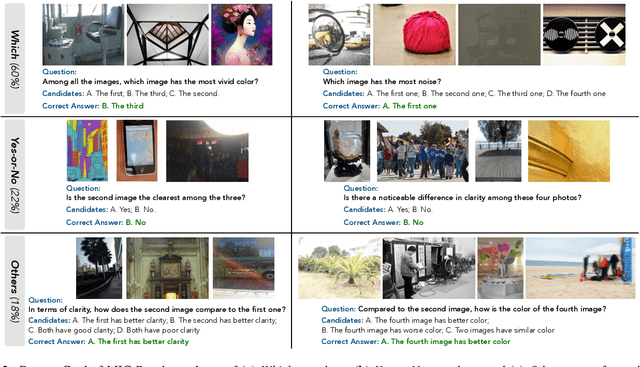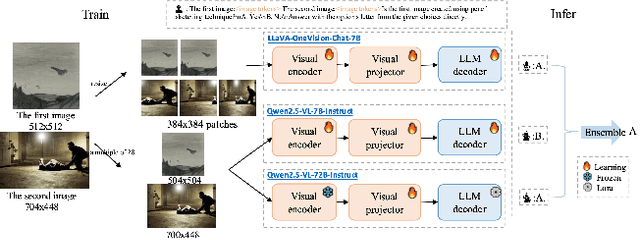Song Jiang
From Solving to Verifying: A Unified Objective for Robust Reasoning in LLMs
Nov 19, 2025Abstract:The reasoning capabilities of large language models (LLMs) have been significantly improved through reinforcement learning (RL). Nevertheless, LLMs still struggle to consistently verify their own reasoning traces. This raises the research question of how to enhance the self-verification ability of LLMs and whether such an ability can further improve reasoning performance. In this work, we propose GRPO-Verif, an algorithm that jointly optimizes solution generation and self-verification within a unified loss function, with an adjustable hyperparameter controlling the weight of the verification signal. Experimental results demonstrate that our method enhances self-verification capability while maintaining comparable performance in reasoning.
AI based signage classification for linguistic landscape studies
Oct 27, 2025Abstract:Linguistic Landscape (LL) research traditionally relies on manual photography and annotation of public signages to examine distribution of languages in urban space. While such methods yield valuable findings, the process is time-consuming and difficult for large study areas. This study explores the use of AI powered language detection method to automate LL analysis. Using Honolulu Chinatown as a case study, we constructed a georeferenced photo dataset of 1,449 images collected by researchers and applied AI for optical character recognition (OCR) and language classification. We also conducted manual validations for accuracy checking. This model achieved an overall accuracy of 79%. Five recurring types of mislabeling were identified, including distortion, reflection, degraded surface, graffiti, and hallucination. The analysis also reveals that the AI model treats all regions of an image equally, detecting peripheral or background texts that human interpreters typically ignore. Despite these limitations, the results demonstrate the potential of integrating AI-assisted workflows into LL research to reduce such time-consuming processes. However, due to all the limitations and mis-labels, we recognize that AI cannot be fully trusted during this process. This paper encourages a hybrid approach combining AI automation with human validation for a more reliable and efficient workflow.
SPG: Sandwiched Policy Gradient for Masked Diffusion Language Models
Oct 10, 2025Abstract:Diffusion large language models (dLLMs) are emerging as an efficient alternative to autoregressive models due to their ability to decode multiple tokens in parallel. However, aligning dLLMs with human preferences or task-specific rewards via reinforcement learning (RL) is challenging because their intractable log-likelihood precludes the direct application of standard policy gradient methods. While prior work uses surrogates like the evidence lower bound (ELBO), these one-sided approximations can introduce significant policy gradient bias. To address this, we propose the Sandwiched Policy Gradient (SPG) that leverages both an upper and a lower bound of the true log-likelihood. Experiments show that SPG significantly outperforms baselines based on ELBO or one-step estimation. Specifically, SPG improves the accuracy over state-of-the-art RL methods for dLLMs by 3.6% in GSM8K, 2.6% in MATH500, 18.4% in Countdown and 27.0% in Sudoku.
VQualA 2025 Challenge on Visual Quality Comparison for Large Multimodal Models: Methods and Results
Sep 11, 2025



Abstract:This paper presents a summary of the VQualA 2025 Challenge on Visual Quality Comparison for Large Multimodal Models (LMMs), hosted as part of the ICCV 2025 Workshop on Visual Quality Assessment. The challenge aims to evaluate and enhance the ability of state-of-the-art LMMs to perform open-ended and detailed reasoning about visual quality differences across multiple images. To this end, the competition introduces a novel benchmark comprising thousands of coarse-to-fine grained visual quality comparison tasks, spanning single images, pairs, and multi-image groups. Each task requires models to provide accurate quality judgments. The competition emphasizes holistic evaluation protocols, including 2AFC-based binary preference and multi-choice questions (MCQs). Around 100 participants submitted entries, with five models demonstrating the emerging capabilities of instruction-tuned LMMs on quality assessment. This challenge marks a significant step toward open-domain visual quality reasoning and comparison and serves as a catalyst for future research on interpretable and human-aligned quality evaluation systems.
FUSE: Measure-Theoretic Compact Fuzzy Set Representation for Taxonomy Expansion
Jun 10, 2025Abstract:Taxonomy Expansion, which models complex concepts and their relations, can be formulated as a set representation learning task. The generalization of set, fuzzy set, incorporates uncertainty and measures the information within a semantic concept, making it suitable for concept modeling. Existing works usually model sets as vectors or geometric objects such as boxes, which are not closed under set operations. In this work, we propose a sound and efficient formulation of set representation learning based on its volume approximation as a fuzzy set. The resulting embedding framework, Fuzzy Set Embedding (FUSE), satisfies all set operations and compactly approximates the underlying fuzzy set, hence preserving information while being efficient to learn, relying on minimum neural architecture. We empirically demonstrate the power of FUSE on the task of taxonomy expansion, where FUSE achieves remarkable improvements up to 23% compared with existing baselines. Our work marks the first attempt to understand and efficiently compute the embeddings of fuzzy sets.
100-LongBench: Are de facto Long-Context Benchmarks Literally Evaluating Long-Context Ability?
May 25, 2025



Abstract:Long-context capability is considered one of the most important abilities of LLMs, as a truly long context-capable LLM enables users to effortlessly process many originally exhausting tasks -- e.g., digesting a long-form document to find answers vs. directly asking an LLM about it. However, existing real-task-based long-context evaluation benchmarks have two major shortcomings. First, benchmarks like LongBench often do not provide proper metrics to separate long-context performance from the model's baseline ability, making cross-model comparison unclear. Second, such benchmarks are usually constructed with fixed input lengths, which limits their applicability across different models and fails to reveal when a model begins to break down. To address these issues, we introduce a length-controllable long-context benchmark and a novel metric that disentangles baseline knowledge from true long-context capabilities. Experiments demonstrate the superiority of our approach in effectively evaluating LLMs.
SWEET-RL: Training Multi-Turn LLM Agents on Collaborative Reasoning Tasks
Mar 19, 2025



Abstract:Large language model (LLM) agents need to perform multi-turn interactions in real-world tasks. However, existing multi-turn RL algorithms for optimizing LLM agents fail to perform effective credit assignment over multiple turns while leveraging the generalization capabilities of LLMs and it remains unclear how to develop such algorithms. To study this, we first introduce a new benchmark, ColBench, where an LLM agent interacts with a human collaborator over multiple turns to solve realistic tasks in backend programming and frontend design. Building on this benchmark, we propose a novel RL algorithm, SWEET-RL (RL with Step-WisE Evaluation from Training-time information), that uses a carefully designed optimization objective to train a critic model with access to additional training-time information. The critic provides step-level rewards for improving the policy model. Our experiments demonstrate that SWEET-RL achieves a 6% absolute improvement in success and win rates on ColBench compared to other state-of-the-art multi-turn RL algorithms, enabling Llama-3.1-8B to match or exceed the performance of GPT4-o in realistic collaborative content creation.
NaturalReasoning: Reasoning in the Wild with 2.8M Challenging Questions
Feb 18, 2025Abstract:Scaling reasoning capabilities beyond traditional domains such as math and coding is hindered by the lack of diverse and high-quality questions. To overcome this limitation, we introduce a scalable approach for generating diverse and challenging reasoning questions, accompanied by reference answers. We present NaturalReasoning, a comprehensive dataset comprising 2.8 million questions that span multiple domains, including STEM fields (e.g., Physics, Computer Science), Economics, Social Sciences, and more. We demonstrate the utility of the questions in NaturalReasoning through knowledge distillation experiments which show that NaturalReasoning can effectively elicit and transfer reasoning capabilities from a strong teacher model. Furthermore, we demonstrate that NaturalReasoning is also effective for unsupervised self-training using external reward models or self-rewarding.
Towards Full Delegation: Designing Ideal Agentic Behaviors for Travel Planning
Nov 21, 2024



Abstract:How are LLM-based agents used in the future? While many of the existing work on agents has focused on improving the performance of a specific family of objective and challenging tasks, in this work, we take a different perspective by thinking about full delegation: agents take over humans' routine decision-making processes and are trusted by humans to find solutions that fit people's personalized needs and are adaptive to ever-changing context. In order to achieve such a goal, the behavior of the agents, i.e., agentic behaviors, should be evaluated not only on their achievements (i.e., outcome evaluation), but also how they achieved that (i.e., procedure evaluation). For this, we propose APEC Agent Constitution, a list of criteria that an agent should follow for good agentic behaviors, including Accuracy, Proactivity, Efficiency and Credibility. To verify whether APEC aligns with human preferences, we develop APEC-Travel, a travel planning agent that proactively extracts hidden personalized needs via multi-round dialog with travelers. APEC-Travel is constructed purely from synthetic data generated by Llama3.1-405B-Instruct with a diverse set of travelers' persona to simulate rich distribution of dialogs. Iteratively fine-tuned to follow APEC Agent Constitution, APEC-Travel surpasses baselines by 20.7% on rule-based metrics and 9.1% on LLM-as-a-Judge scores across the constitution axes.
To the Globe (TTG): Towards Language-Driven Guaranteed Travel Planning
Oct 21, 2024



Abstract:Travel planning is a challenging and time-consuming task that aims to find an itinerary which satisfies multiple, interdependent constraints regarding flights, accommodations, attractions, and other travel arrangements. In this paper, we propose To the Globe (TTG), a real-time demo system that takes natural language requests from users, translates it to symbolic form via a fine-tuned Large Language Model, and produces optimal travel itineraries with Mixed Integer Linear Programming solvers. The overall system takes ~5 seconds to reply to the user request with guaranteed itineraries. To train TTG, we develop a synthetic data pipeline that generates user requests, flight and hotel information in symbolic form without human annotations, based on the statistics of real-world datasets, and fine-tune an LLM to translate NL user requests to their symbolic form, which is sent to the symbolic solver to compute optimal itineraries. Our NL-symbolic translation achieves ~91% exact match in a backtranslation metric (i.e., whether the estimated symbolic form of generated natural language matches the groundtruth), and its returned itineraries have a ratio of 0.979 compared to the optimal cost of the ground truth user request. When evaluated by users, TTG achieves consistently high Net Promoter Scores (NPS) of 35-40% on generated itinerary.
 Add to Chrome
Add to Chrome Add to Firefox
Add to Firefox Add to Edge
Add to Edge